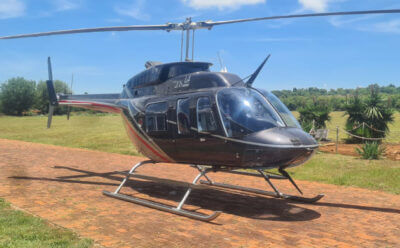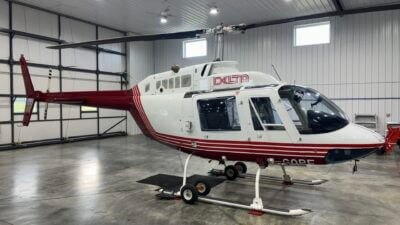BUYING A HELICOPTER
The continually changing face of helicopter insurance
Extra competition in the aviation insurance market brings more flexibility and options for its customers.

By: Jen BoyerPosted on: July 8, 2024
Just before the pandemic, aviation insurance, which had enjoyed several years of historically low rates, took a nasty hit as juries awarded maximum policy limits in accident trials, natural disaster claims picked up an increase in payout, and Boeing cashed in on its policy when the 737 Max 8 was grounded. The insurance industry was bleeding from every angle and aviation insurance underwriters were bailing like rats on a sinking ship.
The result was a smaller pool of aviation insurance underwriters, which reduced competition. The reduced competition paired with increased payouts led to significant rate increases across the industry. It also let underwriters become more selective, leaving some low time pilot owners of high value aircraft facing cost-prohibitive insurance premiums, if they could get a premium at all.
The good news is, the pendulum is beginning to swing the other way, ever so slowly.
“The market is in good shape today compared with five years ago,” explained Rick Ross, president of Leading Edge Insurance Services in Colorado Springs. “While costs aren’t really coming down, the extra competition has brought more flexibility. Underwriting has definitely softened, allowing for a lot more aggression and capacity. Today there is not much out there I can’t get insured.”
Ross explained that after 2001, the insurance industry got significantly aggressive with investment and rate increases. New companies came on the scene willing to underwrite at losses to get into the U.S. market and rate wars ensued. When the losses became too much, some left, and insurance rates started increasing.
“Now we’re seeing more competition again because the rates have increased to where there is a profit to be made,” Ross explained. “Typically, that means we’ll move into a softer market, but that isn’t happening. We’re not seeing prices coming down, at least not now, because they don’t want to make that costly mistake again.
“The companies are making a profit, but they’re not killing it. That’s a good thing because extra competition brings us more flexibility. For instance, it was difficult five years ago to get a low-time pilot insurance in a turbine. Now I can get a pilot with a couple hundred hours into just about any turbine. Maybe not an S-76, but certainly the more popular helicopters for private use.”
The situation is similar in Canada. Ken Britt, aviation underwriter for AXA XL in Calgary, Alberta, sees supply on the rise. While trends in Canada tend to lead those in the U.S., he sees increased insurance flexibility coming to the Great White North.
“Increasing premiums over the past several years provided aviation insurers with much needed capitalization,” he said. “Healthy premiums, coupled with a significant reduction in total aircraft movements throughout the pandemic, may have resulted in an improving claims experience for insurers — though the jury still is out as it takes several years to settle lawsuits defending policyholders and officially close a year of account.
“But with the potential for profitability comes competition, and the market is once again witnessing an increasing number of insurance providers entering the aviation sector with new capital — eager to benefit from current rates in a post-pandemic environment. New entrants will be eager to accept all risk levels to build premiums quickly. Aircraft operators are likely to benefit from the increased availability of insurance products and competition. The past four years, however, are a challenging precursor to the future of premium stability.”

The Benefit for Operators
Those who previously struggled to find insurance will certainly have more options now.
“It’s a soft underwiring market, but not a soft price market,” Ross emphasized. “I don’t see prices changing.”
The current key forces on price are threefold. First, jury payouts for accidents continue to be at maximum coverage.
“In the past, you could have a $50 million insurance policy and settle for a $10 million claim,” Ross explained. “Now, if you paid for that much coverage, and it’s demanded in court, you pay it. In California, if you deny a claim and a jury overturns it, there is no limit to what the jury can award regardless of your insurance coverage. This can actually happen in any state. If the carriers don’t offer up the policy limit, and they lose, the judge can hit them with bad faith and punitive damages. Insurance companies don’t want to be in that position.”
Second, new and used aircraft prices are increasing with increased demand, and parts prices are rising — which requires higher insurance to cover the value, Ross added.
Third, post-pandemic aircraft movement is increasing, and that increases accident potential.
“As total aircraft movements return to their peak, the frequency of reported claims is expected to as well,” said AXA XL’s Britt. “Together with the rising cost of aircraft and components; ongoing supply chain pressures for repairs and replacement; increased awards for liability damages, and so on, these market cycles have generally been shortening in length.
“From a policyholder perspective, this cycle should be met with careful optimism. My advice is to partner with an insurance broker who knows the difference, an insurer you can trust to be with you long-term to help you understand, anticipate, and navigate these cycles.”

Airbus EC120B
Contact seller for price
Year: 2001

Airbus AS350B3
USD $ 1,599,000
Year: 2004

Bell 206L3
Make an offer
Year: 1992

Bell 206L4
Make an offer
Year: 1996

Bell 206B3
Contact seller for price
Year: 1979

Bell 206B3
Contact seller for price
Year: 1980

Airbus AS355F2
Contact seller for price
Year: 1992

Bell 206B3
Contact seller for price
Year: 1973

MD Helicopters 369A
Contact seller for price
Year: 1968

Airbus H125
EUR € 2,400,000
Year: 2020







